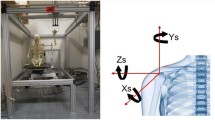Abstract
This study aimed to compare glenohumeral stability during functional tasks in subjects with previous dislocation injury against non-injured controls. Six subjects with previous injury and six controls were asked to complete hand-positioning tasks against external forces applied in six directions. Arm kinematics, muscle activations and hand forces were measured and used as input to an inverse-dynamic model of the shoulder that optimised muscle forces to solve the load-sharing problem. Glenohumeral stability was calculated using the direction of the joint reaction force vector in the glenoid. The simulations showed that GH stability was significantly lower in the previously injured group compared to the controls, and that the direction of exerted forces had a significant effect on GH stability, with the hand pushing away from the body and medially producing significantly lower stability. GH stability was significantly lower in the previously injured group for all six force directions, even though all participants were back to normal activities and reported no symptoms from their injuries.



Similar content being viewed by others
References
Dawson J, Fitzpatrick R, Carr A (1999) The assessment of shoulder instability. J Bone Joint Surg 81:420–426
Gerber C, Ganz R (1984) Clinical assessment of instability of the shoulder with special reference to anterior and posterior drawer tests. J Bone Joint Surg 66:551–555
Groh G, Wirth M, Rockwood C Jr (2010) Results of treatment of luxiato erecta (inferior shoulder dislocation). J Shoulder Elbow Surg 19:423–426
Jobe F, Kvitne R, Giangarra C (1989) Shoulder instability in the overhand or throwing athlete. Orthop Rev 18:1214–1238
Johnson G, Stuart P, Mitchell S (1992) A method for the measurement of three-dimensional scapula movement. Clin Biomech 8:269–273
Kroner K, Lind T, Jensen J (1998) The epidemiology of shoulder dislocations. Arch Orthop Trauma Surg 108:288–290
Marx R, Bombardier C, Wright J (1999) What do we know about the reliability and validity of physical examination tests used to examine the upper extremity? J Hand Surg 24:185–193
McBride T, Kalogrianitis S (2011) Dislocations of the shoulder joint. Trauma 14:47–56
McClure P, Michener L, Sennett B, Karduna A (2001) Direct 3-dimensional measurement of scapular kinematics during dynamic movements in vivo. J Shoulder Elbow Surg 10:269–277
Morris A, Kemp G, Frostick S (2004) Shoulder electromyography in multidirectional instability. J Shoulder Elbow Surg 13:24–29
Nikooyan A, Veeger H, Westerhoff P, Bolsterlee B, Graichen F, Bergmann G, van der Helm F (2012) An emg-driven musculo-skeletalmodel of the shoulder. Hum Mov Sci 31:429–447
Ogston J, Ludewig, P (2007) Differences in 3-dimensional shoulder kinematics between persons with multidirectional instability and asymptomatic controls. Am J Sports Med 35:1361–1370
Praagman M, Chadwick E, van der Helm F, Veeger H (2006) The relationship between two different mechanical cost functions and muscle oxygen consumption. J Biomech 39:758–765
van der Helm F (1994) A finite element musculoskeletal model of the shoulder mechanism. J Biomech 27:511–553
Veeger H, van der Helm F (2007) Shoulder function: the perfect compromise between mobility and stability. J Biomech 40:2119–2129
Wu G, van der Helm F, Veeger H, Makhsous M, Roy P, Anglin C, Nagels J, Karduna A, McQuade K, Wang X, Werner F, Buchholz B (2005) ISB recommendation on denitions of joint coordinate systems of various joints for the reporting of human joint motionpart II: shoulder, elbow, wrist and hand. J Biomech 38:981–992
Acknowledgments
The authors would like to thank Joris Lambrecht (Case Western Reserve University) for the GameStudio visualisation.
Author information
Authors and Affiliations
Corresponding author
Rights and permissions
About this article
Cite this article
Marchi, J., Blana, D. & Chadwick, E.K. Glenohumeral stability during a hand-positioning task in previously injured shoulders. Med Biol Eng Comput 52, 251–256 (2014). https://doi.org/10.1007/s11517-013-1087-9
Received:
Accepted:
Published:
Issue Date:
DOI: https://doi.org/10.1007/s11517-013-1087-9




